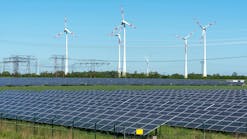The adoption rate of photovoltaic systems reached dizzying heights in Australia in 2012 due to federal and state government incentives, electricity prices, falling photovoltaic system prices and a growing desire by some customers for more control over their electricity supply. PV installation rates slowed until early 2017 when they began increasing again and show no signs of abating. Australian businesses were slower to adopt PV, but that is changing as many now see the economic, environmental and even marketing value.
The percentage of detached houses in Australia with a PV system now exceeds 20% — within the states of Queensland and South Australia it exceeds 30% — creating the highest penetration of rooftop PV in any country in the world. The high rate of PV penetration means electricity distribution network operators (DNOs) must conduct a technical assessment for every application to connect a PV system above a designated capacity (generally 30 kW) to the low-voltage (LV) 415-V or medium-voltage (MV) 11-kV networks. Applications for PV systems with an installed capacity exceeding 30 kW usually are installations on business premises.
Assessing Impact
Australia predominantly has an overhead 230-V network, with underground networks mostly in new developments and inner-city areas. With the highest penetration of PV of all Australian states, Queensland has historically operated a 240-V grid but moved to the 230-V standard, primarily to accommodate even more PV systems.
The DNO does not typically record the network phase to which each service connection is made, which makes phase unbalance problematic in relation to PV system connections.
The assessments the DNOs must perform are complex, time consuming and based, to varying extents, on assumed data. The assessors and their tools must assume a conservative, even worst-case, scenario of electricity demand and PV generation to ensure operation of the PV system will not interfere with the electricity supply to other customers on the local network at any time.
Assessment Outcomes
Increasingly, assessment outcomes dictate the customer must fund network upgrades or adjustments to connect the desired capacity and configuration. Likewise, they will have to pay for network protection devices required to accommodate the addition of a PV system. Sometimes, these unforeseen costs make the PV installation economically unviable for a customer.
Distributors are obliged to juggle with the competing priorities of government, customer and PV industry. There is an expectation customers who want PV systems installed be allowed to have them. However, it is a reality that electricity networks were not originally designed and installed to accommodate the impacts PV systems impose on MV and LV networks.
Some industrial estate developers are looking to leverage PV to help reduce daytime peak demand and, in turn, reduce initial electrical infrastructure costs. A small but increasing number of residential estate developers are installing a PV system and even storage batteries in every house to enhance salability to a market that values lower electricity bills and a greater degree of energy self-sufficiency.
Renewable Energy Agency
To address these issues and simplify the DNOs’ process for assessing PV connections, the University of Queensland launched an exciting two-year A$2.9 million (US$2.14 million) project, partly funded by the Australian Renewable Energy Agency’s (ARENA’s) Advancing Renewables program. The objective of the project is to develop and trial a highly sophisticated distribution network analysis tool designed to lower barriers to the connection of midsized PV systems to the MV or LV networks. All signs are promising that the project, which kicked off in December 2017, will not only deliver on its objective but identify myriad other uses for the state estimation algorithm (SEA) that underpins the analysis tool.
ARENA is interested in seeing network-related impediments to more PV connections reduced. Led by the University of Queensland, the Solar Enablement Initiative also includes electricity distributors Energex, United Energy and TasNetworks, Australian Power Institute, Energy Networks Australia, community builder Springfield City Group, Queensland University of Technology, and engineering and infrastructure advisory company Aurecon.
The project’s key objectives are to demonstrate the semiautomated network analysis tool and enable greater capacities of PV to be accommodated by distribution networks as well as providing a reliable mechanism to enable more flexibility in a PV system’s operation. This would reduce the protective measures a customer must adopt and fund.
The capabilities are to quantify more accurately and efficiently the actual impact of PV on the distribution network, thereby enabling DNOs to allow larger capacities to connect and export energy to the network. This will provide value in increasing the export allowance limits on existing PV systems and eliminate the need for costly network augmentation to accommodate new connections.
State Estimation Algorithm
In simpler terms, the SEA combines and uses data on known parameters of the network, transformer set points and an incomplete set of output measurements to determine the operational conditions at every point in the network. Voltage recording meters in conjunction with statistical data are used to determine the operating state and utilisation of a typical distribution network. From these thousands of pieces of data, the SEA creates a more complete understanding of voltages, load flows and other aspects of the network’s operational state than previously possible.
State estimation is used extensively at the transmission system level, where it enables greatly improved use of the system’s true operational capacity, but—until now—it has not been adapted effectively for use at the distribution network level.
The key reason for this has been a lack of measurement coverage in the distribution network, imbalances between phases, the significant network size and the inability to apply traditional state estimation techniques to networks with insufficient coverage.
In addition, the project will trial the ability of a distributor to use the SEA, among other tools, to reassess dynamically and possibly raise, in real time, current limits imposed on power exports by a PV system at any time, thereby enabling it to export as needed most of the time. This outcome would create financial and other benefits for the customer, increase network utilisation, reduce network risks, enhance network benefits and help green the grid by facilitating much more renewable energy exports than otherwise possible.
Trial Installations
The network analysis tools are being piloted on seven LV distribution network feeders across three distribution networks:
- Energex in southeast Queensland
- United Energy in southeast Melbourne
- Victoria and TasNetworks across Tasmania.
The DNOs have quite different network topologies, data systems and PV penetration rates. The feeders selected also have different implementations, customer types and even weather conditions.
In addition to the A$1.19 million (US$0.88million) in funding from ARENA, the Australian Power Institute, Energy Networks Australia and Springfield City Group all have made cash contributions. All project partners also are providing substantial in-kind contributions, including Energex providing the project manager.
The project’s objective is to deliver a working prototype, rather than a set of tools, to hand over to the participating DNOs to demonstrate the technology developed has the capability to improve the PV assessment approach. Once the prototype has been tested successfully, the next challenge lies in extrapolating it to a whole-of-network solution for the participating distributors as well as other Australian and even international distributors under a commercialised arrangement.
Developer Participation
Springfield City Group is the master developer for Greater Springfield, a large commercial and housing development just southwest of Brisbane. Its involvement in this project reflects the exciting vision the company has for the interconnected role electricity and information technology have in the city’s development.
Springfield will host the first trial of a distributor giving a customer access to dynamic export permissions for controlling the export of a privately owned midsized PV system using SEA as a basis. This element of the project is navigating regulatory, technical and stakeholder issues. However, it has the potential to elevate midsized PV systems from network challenges to network management aids that also deliver enhanced customer financial benefits and environmental outcomes.
A Better Grid
These are exciting times to be helping to create more intelligent electricity grids that enhance their role as enablers of customers’ desire for greater choice and control of their electricity supply and use. While a small minority of customers aspire to disconnect from the grid, for the vast majority—many aspiring to own electric vehicles, store electricity and trade electricity with their neighbours—a more flexible electricity grid run by more flexible DNOs will be the foundation for enhanced customer lifestyles and business activities.
Acknowledgement
The author wishes to thank the core project team at the University of Queensland, including Dr. Olav Krause, for their support and technical input in the preparation of this article.





